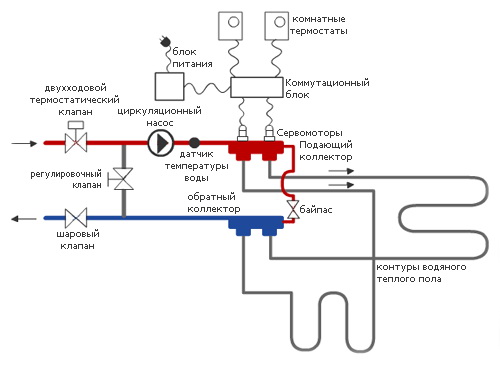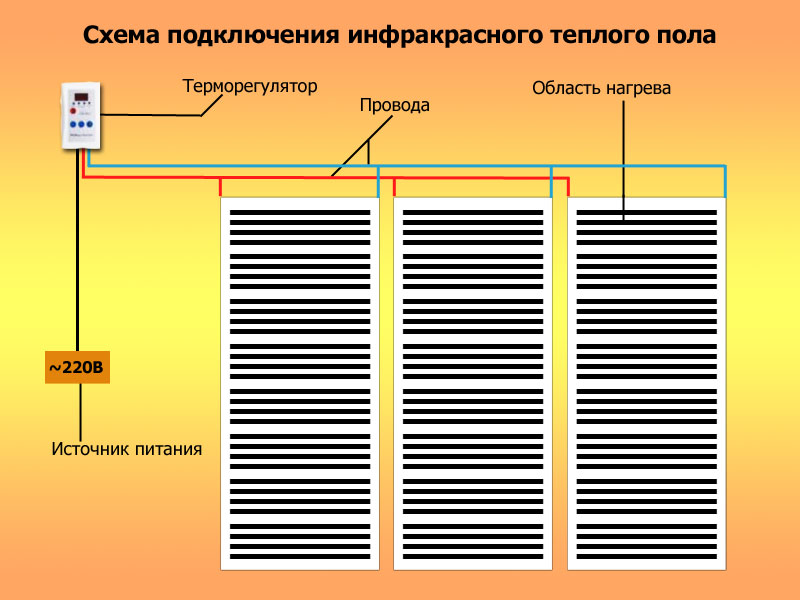Search
Login
Recommended
Manual for self-installation of underfloor heating in the bathroom. Before you make a warm floor in the bathroom, you need to determine its type, electric, water or infrared
Today, the level of development of innovative technologies allows us to consider a warm floor in the bathroom a commonplace. And this is quite justified, since this design feature of the room is not so much an element of luxury associated with a sense of additional comfort, but rather a means of preserving health and maintaining an optimal microclimate in the bathroom. During the off-season, known for its lack of heating, functional underfloor heating will help maintain the necessary temperature conditions.
Content
- Varieties of underfloor heating video
- Electric underfloor heating. Features of construction and installation
- Water floor heating. Advantages and disadvantages, installation features video
- Infrared underfloor heating - an innovation in the construction industry. Benefits
Varieties of underfloor heating
If the idea of \u200b\u200bimproving your home began to visit you more often, and you often began to reflect on the question: How to make a warm floor in the bathroom ?, then this article will help you deal with one of the important stages of installing a warm floor in the bathroom, namely, the selection of the optimal technological Solutions for constructing a warm floor, the most suitable for the bathroom that you dreamed about.


For the implementation of the installation project to create a warm floor, it is necessary to clearly understand the range of design solutions offered by the building materials market, as well as their specific varieties.

There are not so many, there are three main options, which are classified according to a functional basis. These include electric, water and infrared underfloor heating.
Electric underfloor heating. Features of construction and installation
So, in order. The most popular is the system design of electric floors. The installation of this system is usually used for the installation of rooms with a small area and mainly for bathrooms in which the floor is laid with ceramic tiles. At the same time, electric floor heating in the bathroom is not considered an autonomous structure, but, most likely, is part of a centralized heating system. The presence of heating sensors and temperature regulators allows you to adjust the temperature to comfortable numbers.

The main structural components of an electric floor heating are:
1. A heating cable designed to convert electricity energy into thermal energy.
2. Thermostat with a heating sensor to control the system.
3. A tube from corrugated material, a tape for installation of necessary length.
4. Thermal insulation materials.
It is worth emphasizing that the electric system of the underfloor heating in the bathroom is represented by two varieties that do not have fundamental differences, but still have certain features.
Distinguish:
1. A cable underfloor heating, in the system of which the role of the main heating element is played by an electric wire, also having several engineering solutions. At the same time, it is placed under the screed, the thickness of which is in the range of 4 - 7 cm.

2. A floor from thermomats, which, in essence, represents a system consisting of heating cables of various lengths embedded in a textile base. They are equipped with careful insulation and protection against moisture, which contributes to their safe operation. But in this case, the laying of the thermomats is done on a concrete screed, and then they are immersed in a layer of glue for the tile.


Thermomats must be laid with due care so as not to damage the heating elements in their structure, since the repair of the structure involves the complete dismantling of the system. The final stage in the installation solution for the underfloor heating, the main structural unit of which is thermostats, is laying the tiles.
Water floor heating. Advantages and disadvantages, installation features
Another common mounting option is a water heated floor in the bathroom, which also has undeniable advantages.

Firstly, the warm water floors in the bathroom have absolute safety, achieved due to the design features, the main priority of which is recognized as the minimum number of joints and careful masking of all constituent elements.
Secondly, unlike electric, water floors are more economical, since the optimum temperature is achieved while reducing heating costs by a third.

And, thirdly, the indisputable advantage of water floors is the absolute environmental friendliness achieved due to the absence of harmful substances and radiation.

But, like any other constructive project, water floors have a number of disadvantages, the main of which are:
1. The possibility of leakage, the detection of which can take an impressive amount of time,
2. The dependence of the operability and performance of the water floor on the performance of the water pump, which is one of the components of the design,
3. Quite a high level of the cost of installing the system due to the complexity of the engineering structures used during installation.

The design of a water heated floor in the bathroom can be represented by a system of plastic, metal-plastic, steel or copper pipes connected to a central water supply, the role of which is the riser. The purpose of installation of such a design is to create a constant circulation of hot water, thereby achieving floor heating.

The first stage of installation of a water heated floor is the installation of a polypropylene heating riser in case of its absence.

A thorough waterproofing is considered an obligatory step, the purpose of which is to ensure proper protection of the entire structure from unforeseen leaks. At the same time, the materials used for waterproofing are overlapped, and the joints are fastened with a soldering iron or a hair dryer. A rough cement screed is poured over the waterproofing layer. Having completed all of the above recommendations, you can proceed to the direct installation of the water floor, which consists in installing pipes at a distance of no more than 20 cm, as well as attaching them to the main structure.

After sustaining a certain period of time, it is necessary to organize a second screed according to the same principle, and after waiting for it to dry, proceed to laying ceramic tiles.
Infrared underfloor heating - an innovation in the construction industry. Benefits
An innovative technology in construction was the use of an infrared floor in the bathroom, also called film. The indicated system is another constructive solution of the electric underfloor heating in the bathroom, which appeared relatively recently. One of the main advantages of the heating film is the possibility of its installation not only on the floor, but also on the other surfaces of the room.

A distinctive feature of the installation of the infrared floor is the lack of screed, which allows for installation work without lifting the floors.
Also, an indisputable advantage is the parallel connection of heating cables, unlike the classic electric floor, where the wires are connected in series. This feature indicates that in the event of a malfunction of one of the heating elements, the performance of the system as a whole will not be affected.

The principle of functioning of infrared floors is based on the constant emission of infrared rays, which give off thermal energy to the object and heat it like solar energy. The heat donor object, in turn, transfers it along the chain to the next, and so heating occurs.
Thanks to the described principle of operation, favorable conditions of the natural microclimate of the room are easily maintained, since there is no need to burn air oxygen, humidity indicators are also maintained at the proper level. In addition, the convection of air flows is reduced and the circulation of dust particles is regulated, which is subsequently minimized.





